Study Skills for Higher Education: Literature Review & CSR Analysis
VerifiedAdded on 2020/12/18
|11
|2551
|353
Report
AI Summary
This report delves into the significance of literature reviews and corporate social responsibility (CSR) within the context of higher education. It begins by defining literature review as a critical analysis of existing research, emphasizing its role in synthesizing information, identifying knowledge gaps, and guiding decision-making. The report then explores the concept of Corporate Social Responsibility (CSR), examining its evolution, various interpretations, and its integration into business models for positive societal impact. It highlights the drivers of CSR, including bottom-line effects, risk management, and customer loyalty, and discusses relevant theoretical frameworks such as operational efficiency and social contract theory. The report concludes by emphasizing the benefits of CSR activities, such as building consumer loyalty, promoting ethical practices, and fostering strong corporate relationships. The report highlights tactics to express and articulate corporate social responsibility including mission, vision, value statements and advertising with philanthropic activities. The report also discusses the importance of CSR in various aspects of business operations, including employee welfare, environmental sustainability, and community engagement. The report is a valuable resource for students seeking to understand the interconnectedness of these concepts and their relevance in both academic and professional settings.
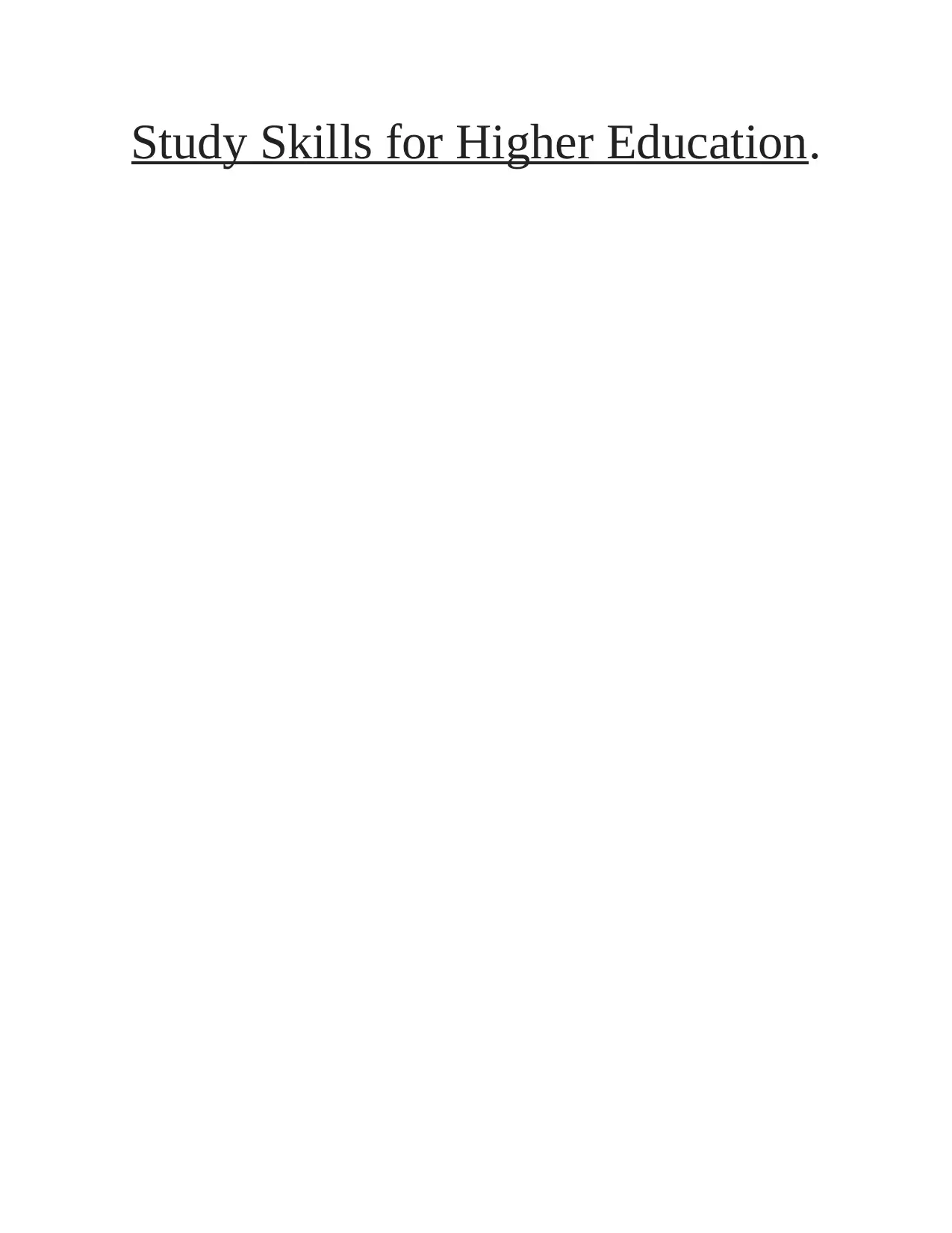
Study Skills for Higher Education.
Paraphrase This Document
Need a fresh take? Get an instant paraphrase of this document with our AI Paraphraser
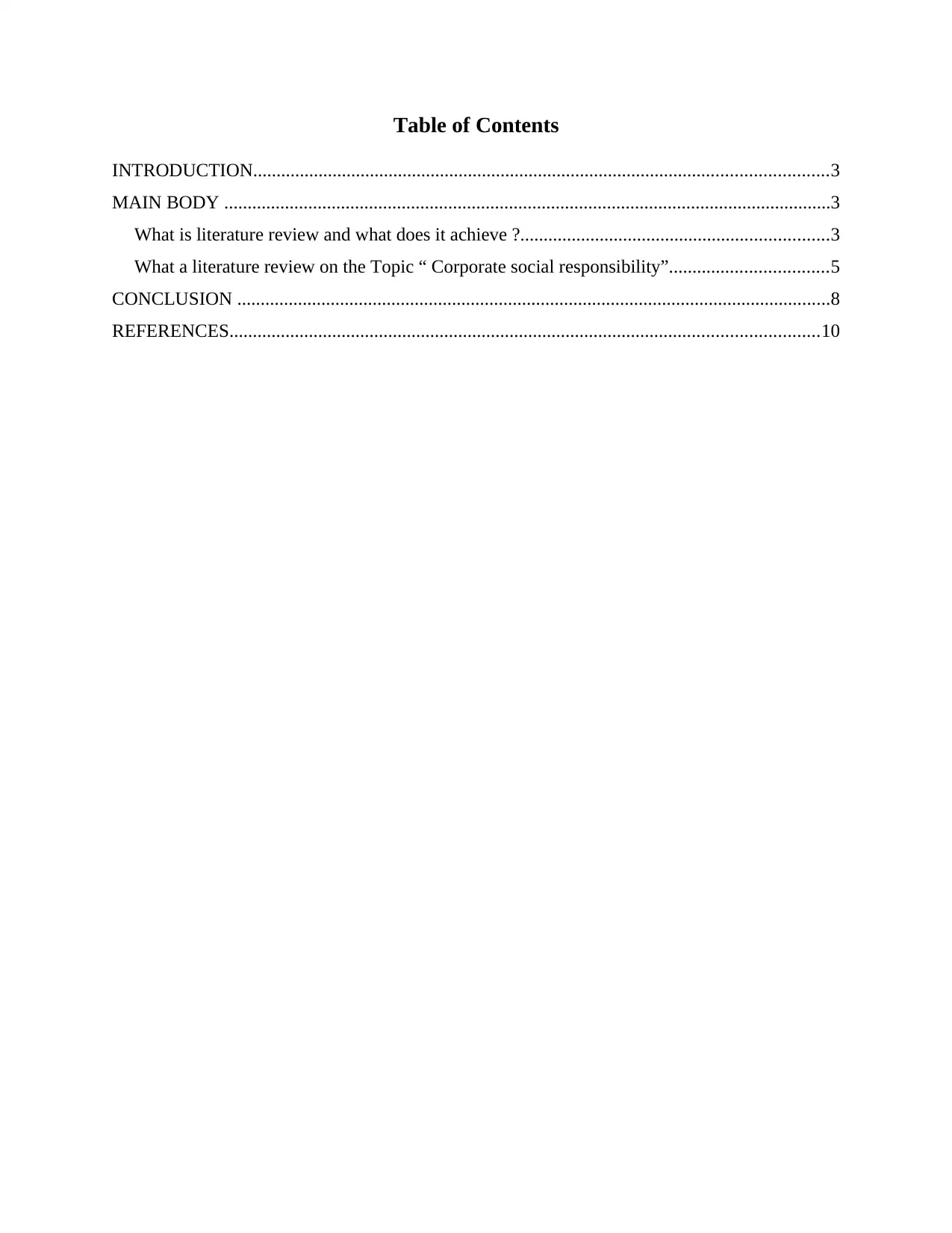
Table of Contents
INTRODUCTION...........................................................................................................................3
MAIN BODY ..................................................................................................................................3
What is literature review and what does it achieve ?..................................................................3
What a literature review on the Topic “ Corporate social responsibility”..................................5
CONCLUSION ...............................................................................................................................8
REFERENCES..............................................................................................................................10
INTRODUCTION...........................................................................................................................3
MAIN BODY ..................................................................................................................................3
What is literature review and what does it achieve ?..................................................................3
What a literature review on the Topic “ Corporate social responsibility”..................................5
CONCLUSION ...............................................................................................................................8
REFERENCES..............................................................................................................................10

⊘ This is a preview!⊘
Do you want full access?
Subscribe today to unlock all pages.

Trusted by 1+ million students worldwide
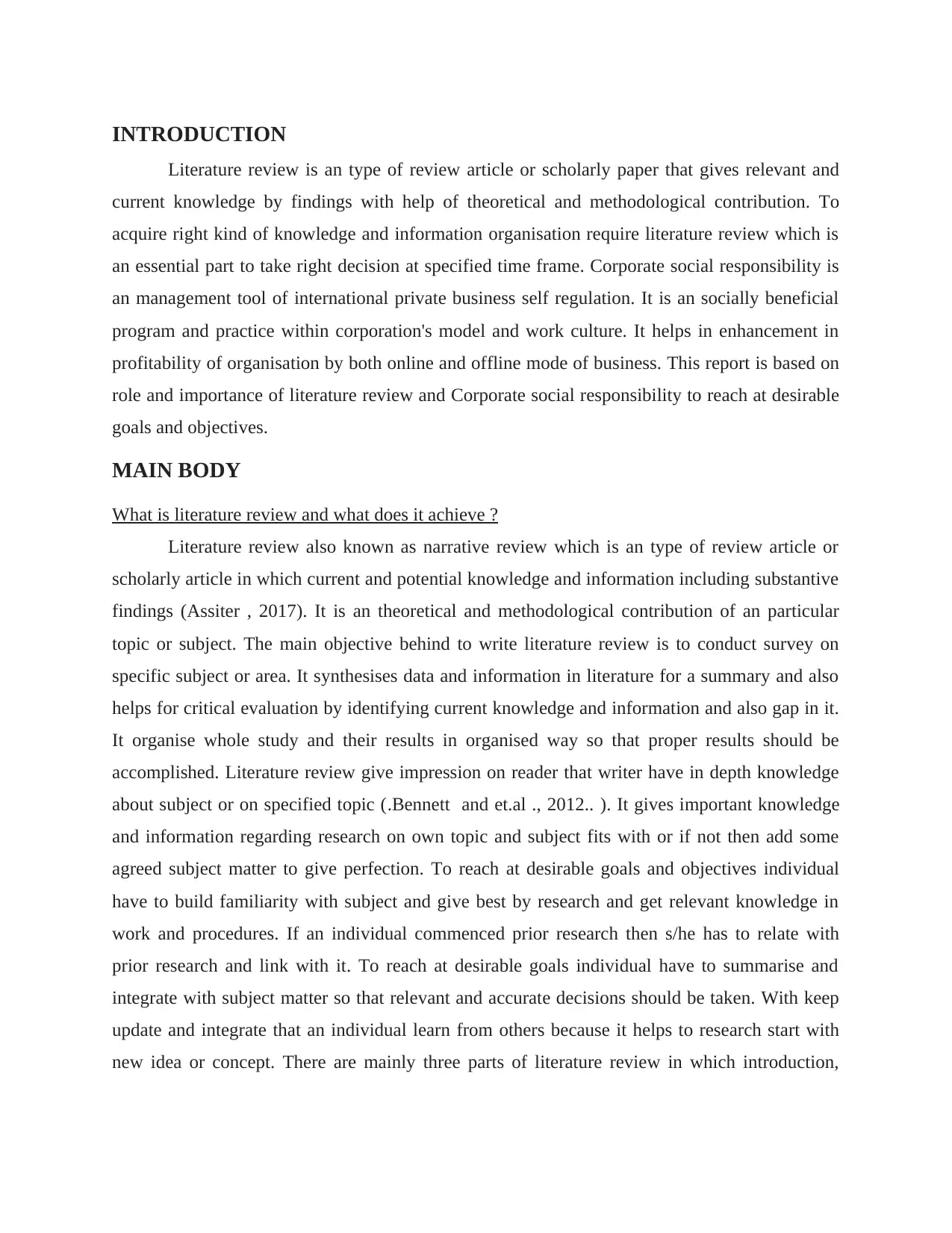
INTRODUCTION
Literature review is an type of review article or scholarly paper that gives relevant and
current knowledge by findings with help of theoretical and methodological contribution. To
acquire right kind of knowledge and information organisation require literature review which is
an essential part to take right decision at specified time frame. Corporate social responsibility is
an management tool of international private business self regulation. It is an socially beneficial
program and practice within corporation's model and work culture. It helps in enhancement in
profitability of organisation by both online and offline mode of business. This report is based on
role and importance of literature review and Corporate social responsibility to reach at desirable
goals and objectives.
MAIN BODY
What is literature review and what does it achieve ?
Literature review also known as narrative review which is an type of review article or
scholarly article in which current and potential knowledge and information including substantive
findings (Assiter , 2017). It is an theoretical and methodological contribution of an particular
topic or subject. The main objective behind to write literature review is to conduct survey on
specific subject or area. It synthesises data and information in literature for a summary and also
helps for critical evaluation by identifying current knowledge and information and also gap in it.
It organise whole study and their results in organised way so that proper results should be
accomplished. Literature review give impression on reader that writer have in depth knowledge
about subject or on specified topic (.Bennett and et.al ., 2012.. ). It gives important knowledge
and information regarding research on own topic and subject fits with or if not then add some
agreed subject matter to give perfection. To reach at desirable goals and objectives individual
have to build familiarity with subject and give best by research and get relevant knowledge in
work and procedures. If an individual commenced prior research then s/he has to relate with
prior research and link with it. To reach at desirable goals individual have to summarise and
integrate with subject matter so that relevant and accurate decisions should be taken. With keep
update and integrate that an individual learn from others because it helps to research start with
new idea or concept. There are mainly three parts of literature review in which introduction,
Literature review is an type of review article or scholarly paper that gives relevant and
current knowledge by findings with help of theoretical and methodological contribution. To
acquire right kind of knowledge and information organisation require literature review which is
an essential part to take right decision at specified time frame. Corporate social responsibility is
an management tool of international private business self regulation. It is an socially beneficial
program and practice within corporation's model and work culture. It helps in enhancement in
profitability of organisation by both online and offline mode of business. This report is based on
role and importance of literature review and Corporate social responsibility to reach at desirable
goals and objectives.
MAIN BODY
What is literature review and what does it achieve ?
Literature review also known as narrative review which is an type of review article or
scholarly article in which current and potential knowledge and information including substantive
findings (Assiter , 2017). It is an theoretical and methodological contribution of an particular
topic or subject. The main objective behind to write literature review is to conduct survey on
specific subject or area. It synthesises data and information in literature for a summary and also
helps for critical evaluation by identifying current knowledge and information and also gap in it.
It organise whole study and their results in organised way so that proper results should be
accomplished. Literature review give impression on reader that writer have in depth knowledge
about subject or on specified topic (.Bennett and et.al ., 2012.. ). It gives important knowledge
and information regarding research on own topic and subject fits with or if not then add some
agreed subject matter to give perfection. To reach at desirable goals and objectives individual
have to build familiarity with subject and give best by research and get relevant knowledge in
work and procedures. If an individual commenced prior research then s/he has to relate with
prior research and link with it. To reach at desirable goals individual have to summarise and
integrate with subject matter so that relevant and accurate decisions should be taken. With keep
update and integrate that an individual learn from others because it helps to research start with
new idea or concept. There are mainly three parts of literature review in which introduction,
Paraphrase This Document
Need a fresh take? Get an instant paraphrase of this document with our AI Paraphraser
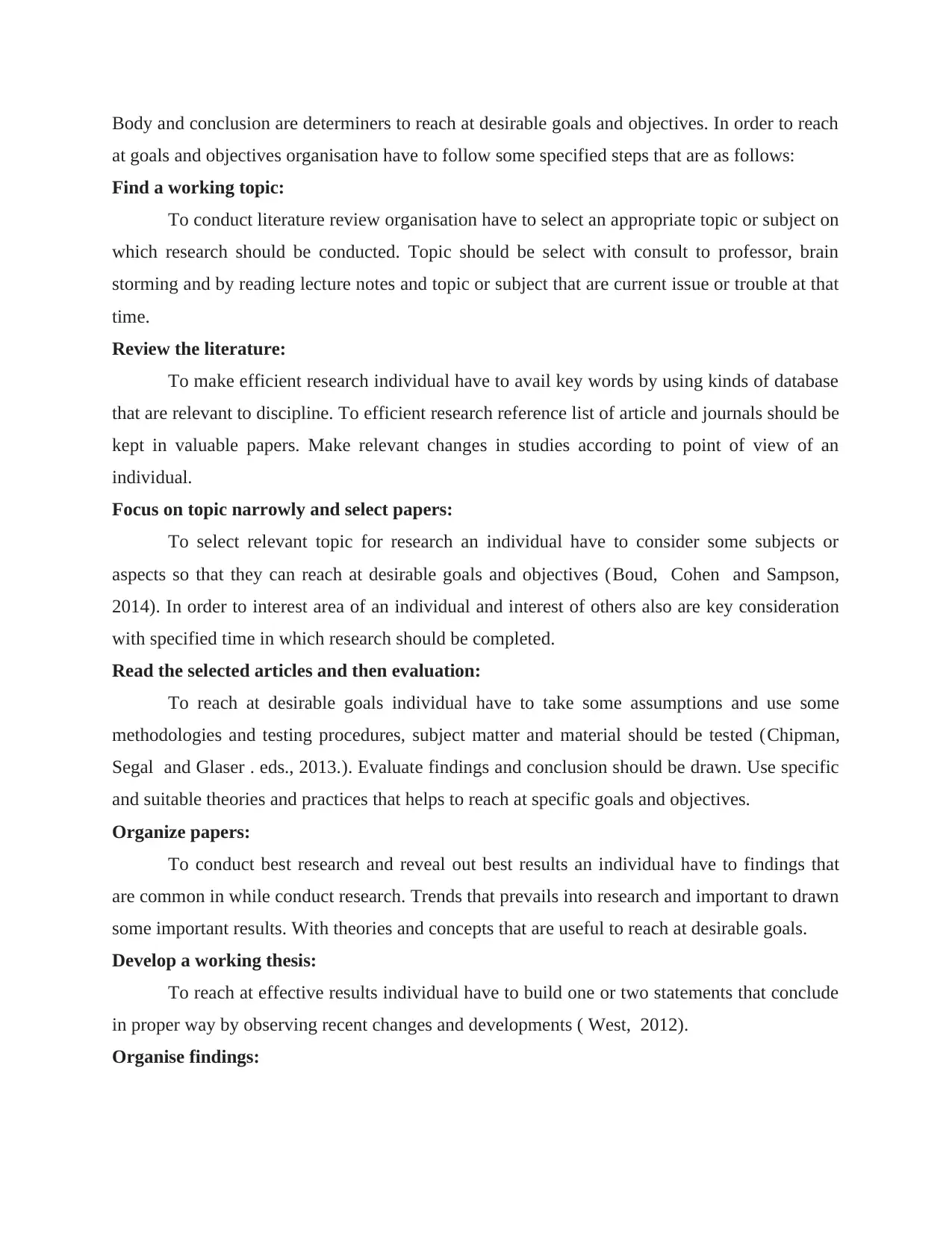
Body and conclusion are determiners to reach at desirable goals and objectives. In order to reach
at goals and objectives organisation have to follow some specified steps that are as follows:
Find a working topic:
To conduct literature review organisation have to select an appropriate topic or subject on
which research should be conducted. Topic should be select with consult to professor, brain
storming and by reading lecture notes and topic or subject that are current issue or trouble at that
time.
Review the literature:
To make efficient research individual have to avail key words by using kinds of database
that are relevant to discipline. To efficient research reference list of article and journals should be
kept in valuable papers. Make relevant changes in studies according to point of view of an
individual.
Focus on topic narrowly and select papers:
To select relevant topic for research an individual have to consider some subjects or
aspects so that they can reach at desirable goals and objectives (Boud, Cohen and Sampson,
2014). In order to interest area of an individual and interest of others also are key consideration
with specified time in which research should be completed.
Read the selected articles and then evaluation:
To reach at desirable goals individual have to take some assumptions and use some
methodologies and testing procedures, subject matter and material should be tested (Chipman,
Segal and Glaser . eds., 2013.). Evaluate findings and conclusion should be drawn. Use specific
and suitable theories and practices that helps to reach at specific goals and objectives.
Organize papers:
To conduct best research and reveal out best results an individual have to findings that
are common in while conduct research. Trends that prevails into research and important to drawn
some important results. With theories and concepts that are useful to reach at desirable goals.
Develop a working thesis:
To reach at effective results individual have to build one or two statements that conclude
in proper way by observing recent changes and developments ( West, 2012).
Organise findings:
at goals and objectives organisation have to follow some specified steps that are as follows:
Find a working topic:
To conduct literature review organisation have to select an appropriate topic or subject on
which research should be conducted. Topic should be select with consult to professor, brain
storming and by reading lecture notes and topic or subject that are current issue or trouble at that
time.
Review the literature:
To make efficient research individual have to avail key words by using kinds of database
that are relevant to discipline. To efficient research reference list of article and journals should be
kept in valuable papers. Make relevant changes in studies according to point of view of an
individual.
Focus on topic narrowly and select papers:
To select relevant topic for research an individual have to consider some subjects or
aspects so that they can reach at desirable goals and objectives (Boud, Cohen and Sampson,
2014). In order to interest area of an individual and interest of others also are key consideration
with specified time in which research should be completed.
Read the selected articles and then evaluation:
To reach at desirable goals individual have to take some assumptions and use some
methodologies and testing procedures, subject matter and material should be tested (Chipman,
Segal and Glaser . eds., 2013.). Evaluate findings and conclusion should be drawn. Use specific
and suitable theories and practices that helps to reach at specific goals and objectives.
Organize papers:
To conduct best research and reveal out best results an individual have to findings that
are common in while conduct research. Trends that prevails into research and important to drawn
some important results. With theories and concepts that are useful to reach at desirable goals.
Develop a working thesis:
To reach at effective results individual have to build one or two statements that conclude
in proper way by observing recent changes and developments ( West, 2012).
Organise findings:
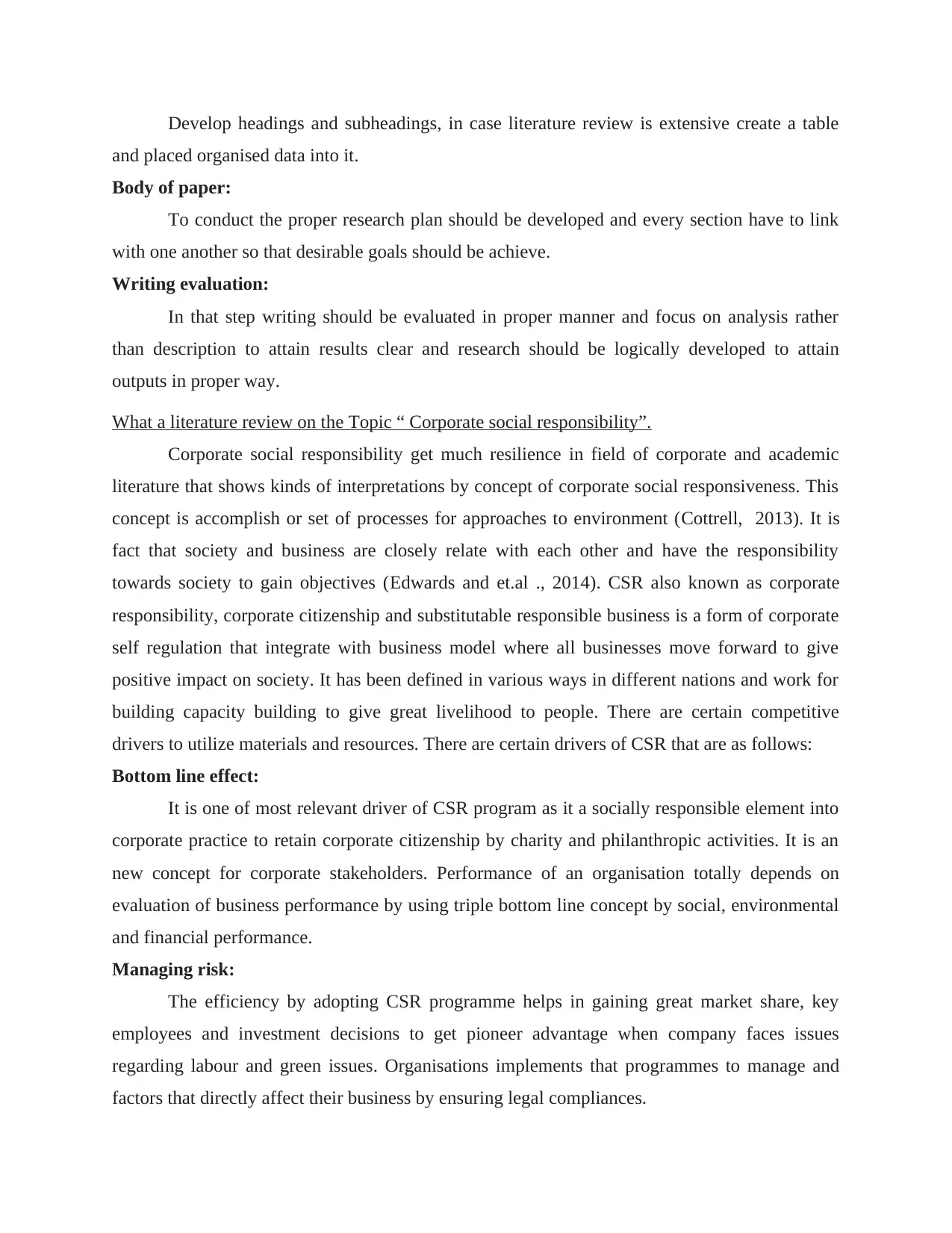
Develop headings and subheadings, in case literature review is extensive create a table
and placed organised data into it.
Body of paper:
To conduct the proper research plan should be developed and every section have to link
with one another so that desirable goals should be achieve.
Writing evaluation:
In that step writing should be evaluated in proper manner and focus on analysis rather
than description to attain results clear and research should be logically developed to attain
outputs in proper way.
What a literature review on the Topic “ Corporate social responsibility”.
Corporate social responsibility get much resilience in field of corporate and academic
literature that shows kinds of interpretations by concept of corporate social responsiveness. This
concept is accomplish or set of processes for approaches to environment (Cottrell, 2013). It is
fact that society and business are closely relate with each other and have the responsibility
towards society to gain objectives (Edwards and et.al ., 2014). CSR also known as corporate
responsibility, corporate citizenship and substitutable responsible business is a form of corporate
self regulation that integrate with business model where all businesses move forward to give
positive impact on society. It has been defined in various ways in different nations and work for
building capacity building to give great livelihood to people. There are certain competitive
drivers to utilize materials and resources. There are certain drivers of CSR that are as follows:
Bottom line effect:
It is one of most relevant driver of CSR program as it a socially responsible element into
corporate practice to retain corporate citizenship by charity and philanthropic activities. It is an
new concept for corporate stakeholders. Performance of an organisation totally depends on
evaluation of business performance by using triple bottom line concept by social, environmental
and financial performance.
Managing risk:
The efficiency by adopting CSR programme helps in gaining great market share, key
employees and investment decisions to get pioneer advantage when company faces issues
regarding labour and green issues. Organisations implements that programmes to manage and
factors that directly affect their business by ensuring legal compliances.
and placed organised data into it.
Body of paper:
To conduct the proper research plan should be developed and every section have to link
with one another so that desirable goals should be achieve.
Writing evaluation:
In that step writing should be evaluated in proper manner and focus on analysis rather
than description to attain results clear and research should be logically developed to attain
outputs in proper way.
What a literature review on the Topic “ Corporate social responsibility”.
Corporate social responsibility get much resilience in field of corporate and academic
literature that shows kinds of interpretations by concept of corporate social responsiveness. This
concept is accomplish or set of processes for approaches to environment (Cottrell, 2013). It is
fact that society and business are closely relate with each other and have the responsibility
towards society to gain objectives (Edwards and et.al ., 2014). CSR also known as corporate
responsibility, corporate citizenship and substitutable responsible business is a form of corporate
self regulation that integrate with business model where all businesses move forward to give
positive impact on society. It has been defined in various ways in different nations and work for
building capacity building to give great livelihood to people. There are certain competitive
drivers to utilize materials and resources. There are certain drivers of CSR that are as follows:
Bottom line effect:
It is one of most relevant driver of CSR program as it a socially responsible element into
corporate practice to retain corporate citizenship by charity and philanthropic activities. It is an
new concept for corporate stakeholders. Performance of an organisation totally depends on
evaluation of business performance by using triple bottom line concept by social, environmental
and financial performance.
Managing risk:
The efficiency by adopting CSR programme helps in gaining great market share, key
employees and investment decisions to get pioneer advantage when company faces issues
regarding labour and green issues. Organisations implements that programmes to manage and
factors that directly affect their business by ensuring legal compliances.
⊘ This is a preview!⊘
Do you want full access?
Subscribe today to unlock all pages.

Trusted by 1+ million students worldwide
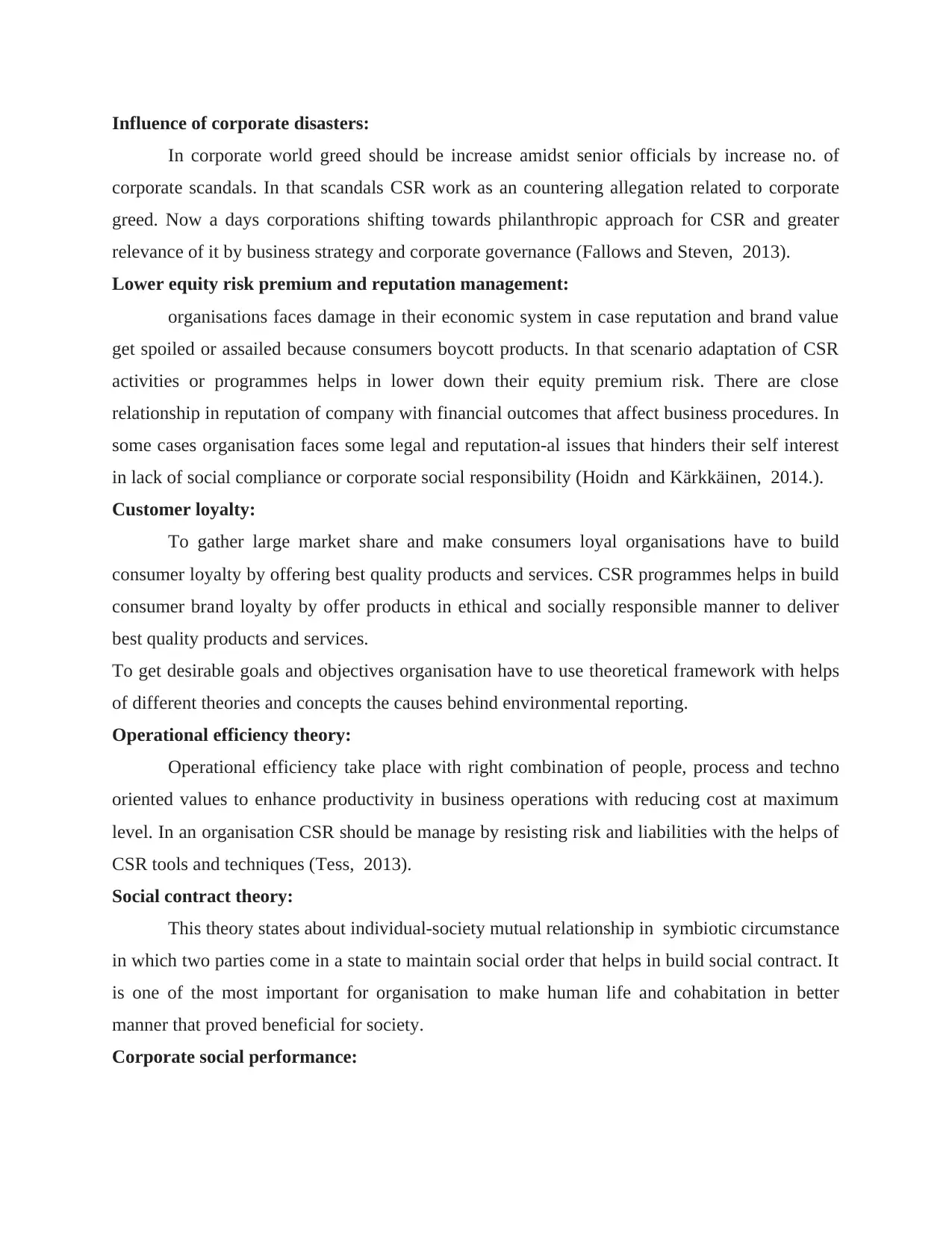
Influence of corporate disasters:
In corporate world greed should be increase amidst senior officials by increase no. of
corporate scandals. In that scandals CSR work as an countering allegation related to corporate
greed. Now a days corporations shifting towards philanthropic approach for CSR and greater
relevance of it by business strategy and corporate governance (Fallows and Steven, 2013).
Lower equity risk premium and reputation management:
organisations faces damage in their economic system in case reputation and brand value
get spoiled or assailed because consumers boycott products. In that scenario adaptation of CSR
activities or programmes helps in lower down their equity premium risk. There are close
relationship in reputation of company with financial outcomes that affect business procedures. In
some cases organisation faces some legal and reputation-al issues that hinders their self interest
in lack of social compliance or corporate social responsibility (Hoidn and Kärkkäinen, 2014.).
Customer loyalty:
To gather large market share and make consumers loyal organisations have to build
consumer loyalty by offering best quality products and services. CSR programmes helps in build
consumer brand loyalty by offer products in ethical and socially responsible manner to deliver
best quality products and services.
To get desirable goals and objectives organisation have to use theoretical framework with helps
of different theories and concepts the causes behind environmental reporting.
Operational efficiency theory:
Operational efficiency take place with right combination of people, process and techno
oriented values to enhance productivity in business operations with reducing cost at maximum
level. In an organisation CSR should be manage by resisting risk and liabilities with the helps of
CSR tools and techniques (Tess, 2013).
Social contract theory:
This theory states about individual-society mutual relationship in symbiotic circumstance
in which two parties come in a state to maintain social order that helps in build social contract. It
is one of the most important for organisation to make human life and cohabitation in better
manner that proved beneficial for society.
Corporate social performance:
In corporate world greed should be increase amidst senior officials by increase no. of
corporate scandals. In that scandals CSR work as an countering allegation related to corporate
greed. Now a days corporations shifting towards philanthropic approach for CSR and greater
relevance of it by business strategy and corporate governance (Fallows and Steven, 2013).
Lower equity risk premium and reputation management:
organisations faces damage in their economic system in case reputation and brand value
get spoiled or assailed because consumers boycott products. In that scenario adaptation of CSR
activities or programmes helps in lower down their equity premium risk. There are close
relationship in reputation of company with financial outcomes that affect business procedures. In
some cases organisation faces some legal and reputation-al issues that hinders their self interest
in lack of social compliance or corporate social responsibility (Hoidn and Kärkkäinen, 2014.).
Customer loyalty:
To gather large market share and make consumers loyal organisations have to build
consumer loyalty by offering best quality products and services. CSR programmes helps in build
consumer brand loyalty by offer products in ethical and socially responsible manner to deliver
best quality products and services.
To get desirable goals and objectives organisation have to use theoretical framework with helps
of different theories and concepts the causes behind environmental reporting.
Operational efficiency theory:
Operational efficiency take place with right combination of people, process and techno
oriented values to enhance productivity in business operations with reducing cost at maximum
level. In an organisation CSR should be manage by resisting risk and liabilities with the helps of
CSR tools and techniques (Tess, 2013).
Social contract theory:
This theory states about individual-society mutual relationship in symbiotic circumstance
in which two parties come in a state to maintain social order that helps in build social contract. It
is one of the most important for organisation to make human life and cohabitation in better
manner that proved beneficial for society.
Corporate social performance:
Paraphrase This Document
Need a fresh take? Get an instant paraphrase of this document with our AI Paraphraser
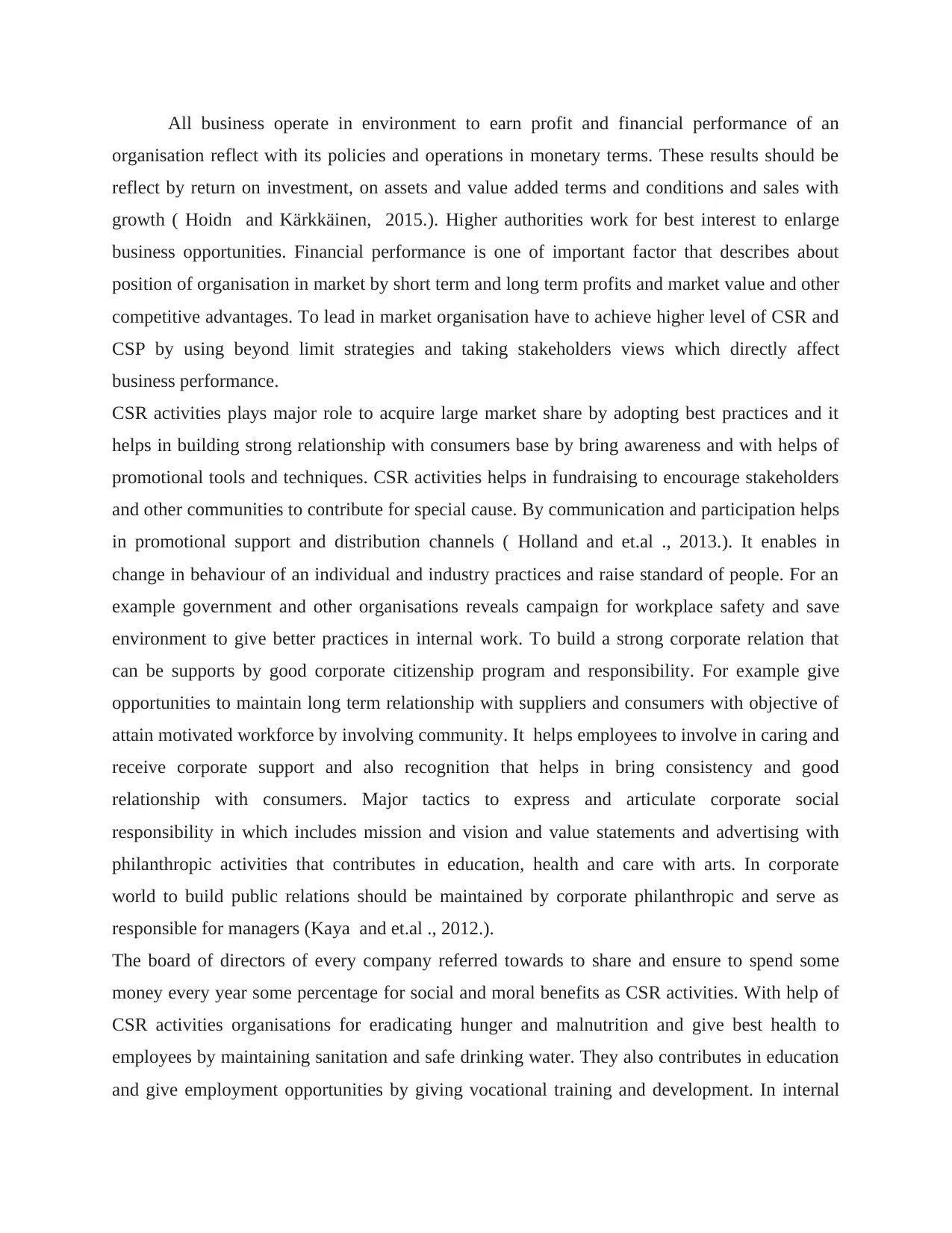
All business operate in environment to earn profit and financial performance of an
organisation reflect with its policies and operations in monetary terms. These results should be
reflect by return on investment, on assets and value added terms and conditions and sales with
growth ( Hoidn and Kärkkäinen, 2015.). Higher authorities work for best interest to enlarge
business opportunities. Financial performance is one of important factor that describes about
position of organisation in market by short term and long term profits and market value and other
competitive advantages. To lead in market organisation have to achieve higher level of CSR and
CSP by using beyond limit strategies and taking stakeholders views which directly affect
business performance.
CSR activities plays major role to acquire large market share by adopting best practices and it
helps in building strong relationship with consumers base by bring awareness and with helps of
promotional tools and techniques. CSR activities helps in fundraising to encourage stakeholders
and other communities to contribute for special cause. By communication and participation helps
in promotional support and distribution channels ( Holland and et.al ., 2013.). It enables in
change in behaviour of an individual and industry practices and raise standard of people. For an
example government and other organisations reveals campaign for workplace safety and save
environment to give better practices in internal work. To build a strong corporate relation that
can be supports by good corporate citizenship program and responsibility. For example give
opportunities to maintain long term relationship with suppliers and consumers with objective of
attain motivated workforce by involving community. It helps employees to involve in caring and
receive corporate support and also recognition that helps in bring consistency and good
relationship with consumers. Major tactics to express and articulate corporate social
responsibility in which includes mission and vision and value statements and advertising with
philanthropic activities that contributes in education, health and care with arts. In corporate
world to build public relations should be maintained by corporate philanthropic and serve as
responsible for managers (Kaya and et.al ., 2012.).
The board of directors of every company referred towards to share and ensure to spend some
money every year some percentage for social and moral benefits as CSR activities. With help of
CSR activities organisations for eradicating hunger and malnutrition and give best health to
employees by maintaining sanitation and safe drinking water. They also contributes in education
and give employment opportunities by giving vocational training and development. In internal
organisation reflect with its policies and operations in monetary terms. These results should be
reflect by return on investment, on assets and value added terms and conditions and sales with
growth ( Hoidn and Kärkkäinen, 2015.). Higher authorities work for best interest to enlarge
business opportunities. Financial performance is one of important factor that describes about
position of organisation in market by short term and long term profits and market value and other
competitive advantages. To lead in market organisation have to achieve higher level of CSR and
CSP by using beyond limit strategies and taking stakeholders views which directly affect
business performance.
CSR activities plays major role to acquire large market share by adopting best practices and it
helps in building strong relationship with consumers base by bring awareness and with helps of
promotional tools and techniques. CSR activities helps in fundraising to encourage stakeholders
and other communities to contribute for special cause. By communication and participation helps
in promotional support and distribution channels ( Holland and et.al ., 2013.). It enables in
change in behaviour of an individual and industry practices and raise standard of people. For an
example government and other organisations reveals campaign for workplace safety and save
environment to give better practices in internal work. To build a strong corporate relation that
can be supports by good corporate citizenship program and responsibility. For example give
opportunities to maintain long term relationship with suppliers and consumers with objective of
attain motivated workforce by involving community. It helps employees to involve in caring and
receive corporate support and also recognition that helps in bring consistency and good
relationship with consumers. Major tactics to express and articulate corporate social
responsibility in which includes mission and vision and value statements and advertising with
philanthropic activities that contributes in education, health and care with arts. In corporate
world to build public relations should be maintained by corporate philanthropic and serve as
responsible for managers (Kaya and et.al ., 2012.).
The board of directors of every company referred towards to share and ensure to spend some
money every year some percentage for social and moral benefits as CSR activities. With help of
CSR activities organisations for eradicating hunger and malnutrition and give best health to
employees by maintaining sanitation and safe drinking water. They also contributes in education
and give employment opportunities by giving vocational training and development. In internal
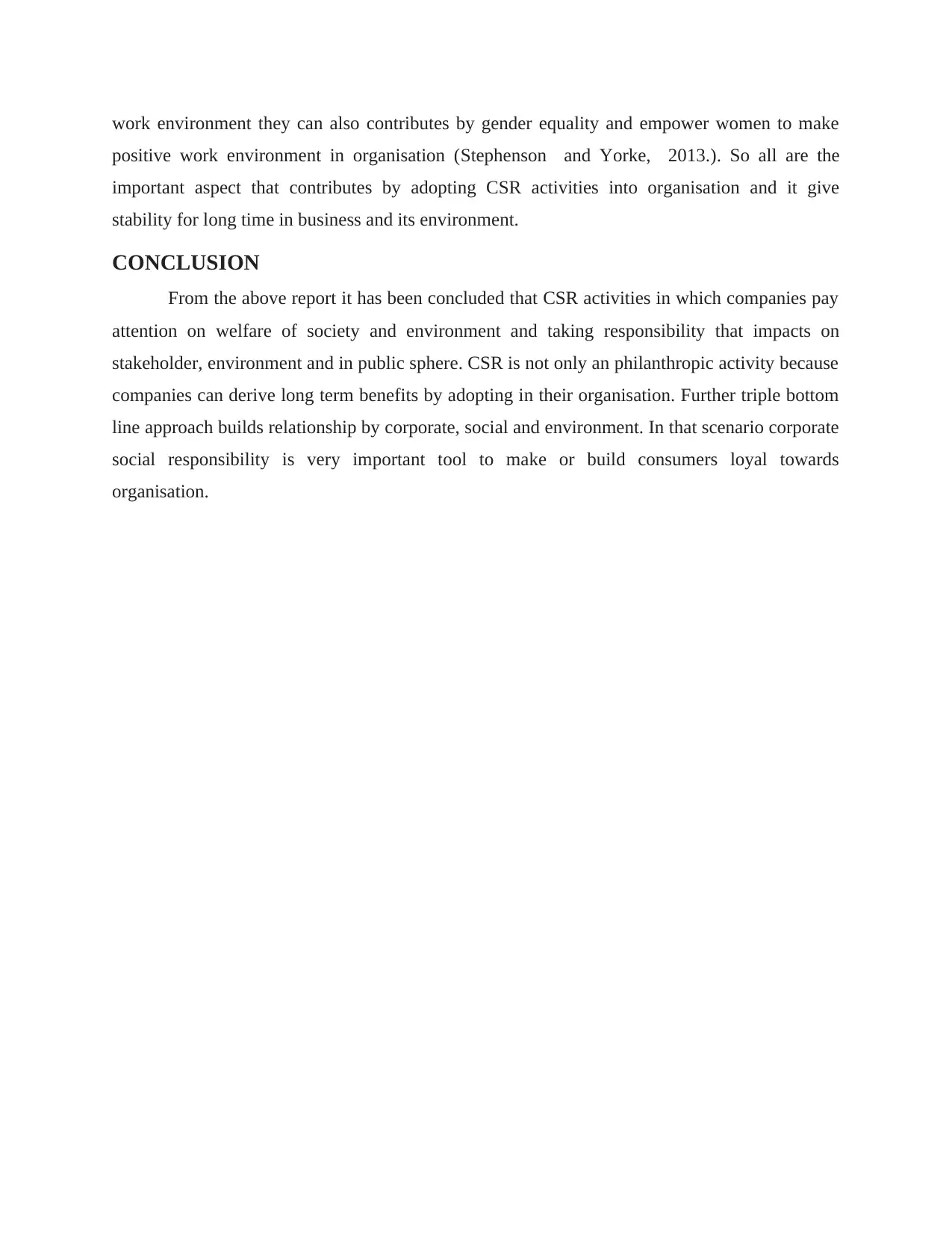
work environment they can also contributes by gender equality and empower women to make
positive work environment in organisation (Stephenson and Yorke, 2013.). So all are the
important aspect that contributes by adopting CSR activities into organisation and it give
stability for long time in business and its environment.
CONCLUSION
From the above report it has been concluded that CSR activities in which companies pay
attention on welfare of society and environment and taking responsibility that impacts on
stakeholder, environment and in public sphere. CSR is not only an philanthropic activity because
companies can derive long term benefits by adopting in their organisation. Further triple bottom
line approach builds relationship by corporate, social and environment. In that scenario corporate
social responsibility is very important tool to make or build consumers loyal towards
organisation.
positive work environment in organisation (Stephenson and Yorke, 2013.). So all are the
important aspect that contributes by adopting CSR activities into organisation and it give
stability for long time in business and its environment.
CONCLUSION
From the above report it has been concluded that CSR activities in which companies pay
attention on welfare of society and environment and taking responsibility that impacts on
stakeholder, environment and in public sphere. CSR is not only an philanthropic activity because
companies can derive long term benefits by adopting in their organisation. Further triple bottom
line approach builds relationship by corporate, social and environment. In that scenario corporate
social responsibility is very important tool to make or build consumers loyal towards
organisation.
⊘ This is a preview!⊘
Do you want full access?
Subscribe today to unlock all pages.

Trusted by 1+ million students worldwide
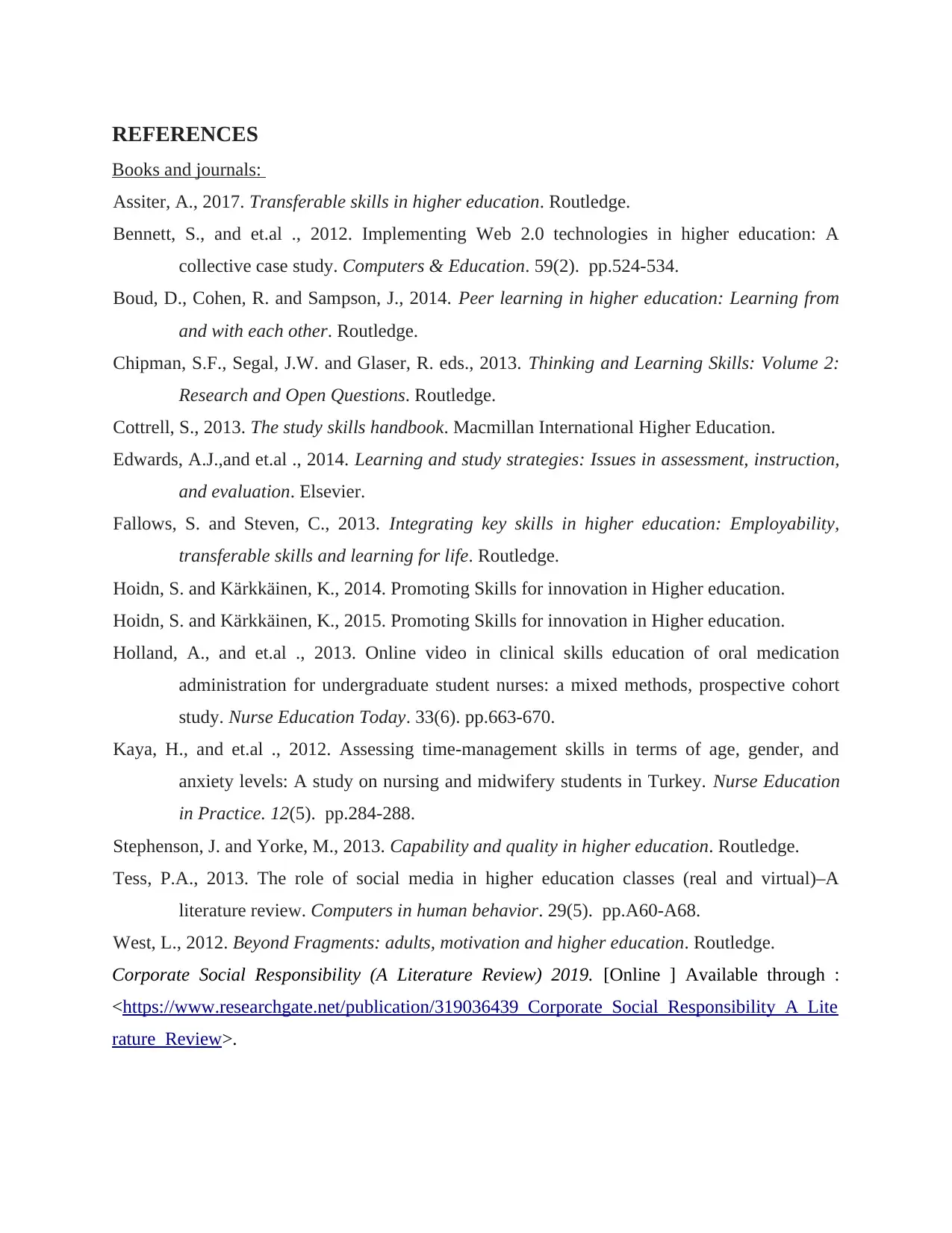
REFERENCES
Books and journals:
Assiter, A., 2017. Transferable skills in higher education. Routledge.
Bennett, S., and et.al ., 2012. Implementing Web 2.0 technologies in higher education: A
collective case study. Computers & Education. 59(2). pp.524-534.
Boud, D., Cohen, R. and Sampson, J., 2014. Peer learning in higher education: Learning from
and with each other. Routledge.
Chipman, S.F., Segal, J.W. and Glaser, R. eds., 2013. Thinking and Learning Skills: Volume 2:
Research and Open Questions. Routledge.
Cottrell, S., 2013. The study skills handbook. Macmillan International Higher Education.
Edwards, A.J.,and et.al ., 2014. Learning and study strategies: Issues in assessment, instruction,
and evaluation. Elsevier.
Fallows, S. and Steven, C., 2013. Integrating key skills in higher education: Employability,
transferable skills and learning for life. Routledge.
Hoidn, S. and Kärkkäinen, K., 2014. Promoting Skills for innovation in Higher education.
Hoidn, S. and Kärkkäinen, K., 2015. Promoting Skills for innovation in Higher education.
Holland, A., and et.al ., 2013. Online video in clinical skills education of oral medication
administration for undergraduate student nurses: a mixed methods, prospective cohort
study. Nurse Education Today. 33(6). pp.663-670.
Kaya, H., and et.al ., 2012. Assessing time-management skills in terms of age, gender, and
anxiety levels: A study on nursing and midwifery students in Turkey. Nurse Education
in Practice. 12(5). pp.284-288.
Stephenson, J. and Yorke, M., 2013. Capability and quality in higher education. Routledge.
Tess, P.A., 2013. The role of social media in higher education classes (real and virtual)–A
literature review. Computers in human behavior. 29(5). pp.A60-A68.
West, L., 2012. Beyond Fragments: adults, motivation and higher education. Routledge.
Corporate Social Responsibility (A Literature Review) 2019. [Online ] Available through :
<https://www.researchgate.net/publication/319036439_Corporate_Social_Responsibility_A_Lite
rature_Review>.
Books and journals:
Assiter, A., 2017. Transferable skills in higher education. Routledge.
Bennett, S., and et.al ., 2012. Implementing Web 2.0 technologies in higher education: A
collective case study. Computers & Education. 59(2). pp.524-534.
Boud, D., Cohen, R. and Sampson, J., 2014. Peer learning in higher education: Learning from
and with each other. Routledge.
Chipman, S.F., Segal, J.W. and Glaser, R. eds., 2013. Thinking and Learning Skills: Volume 2:
Research and Open Questions. Routledge.
Cottrell, S., 2013. The study skills handbook. Macmillan International Higher Education.
Edwards, A.J.,and et.al ., 2014. Learning and study strategies: Issues in assessment, instruction,
and evaluation. Elsevier.
Fallows, S. and Steven, C., 2013. Integrating key skills in higher education: Employability,
transferable skills and learning for life. Routledge.
Hoidn, S. and Kärkkäinen, K., 2014. Promoting Skills for innovation in Higher education.
Hoidn, S. and Kärkkäinen, K., 2015. Promoting Skills for innovation in Higher education.
Holland, A., and et.al ., 2013. Online video in clinical skills education of oral medication
administration for undergraduate student nurses: a mixed methods, prospective cohort
study. Nurse Education Today. 33(6). pp.663-670.
Kaya, H., and et.al ., 2012. Assessing time-management skills in terms of age, gender, and
anxiety levels: A study on nursing and midwifery students in Turkey. Nurse Education
in Practice. 12(5). pp.284-288.
Stephenson, J. and Yorke, M., 2013. Capability and quality in higher education. Routledge.
Tess, P.A., 2013. The role of social media in higher education classes (real and virtual)–A
literature review. Computers in human behavior. 29(5). pp.A60-A68.
West, L., 2012. Beyond Fragments: adults, motivation and higher education. Routledge.
Corporate Social Responsibility (A Literature Review) 2019. [Online ] Available through :
<https://www.researchgate.net/publication/319036439_Corporate_Social_Responsibility_A_Lite
rature_Review>.
Paraphrase This Document
Need a fresh take? Get an instant paraphrase of this document with our AI Paraphraser

1 out of 11
Related Documents
Your All-in-One AI-Powered Toolkit for Academic Success.
+13062052269
info@desklib.com
Available 24*7 on WhatsApp / Email
![[object Object]](/_next/static/media/star-bottom.7253800d.svg)
Unlock your academic potential
Copyright © 2020–2025 A2Z Services. All Rights Reserved. Developed and managed by ZUCOL.





